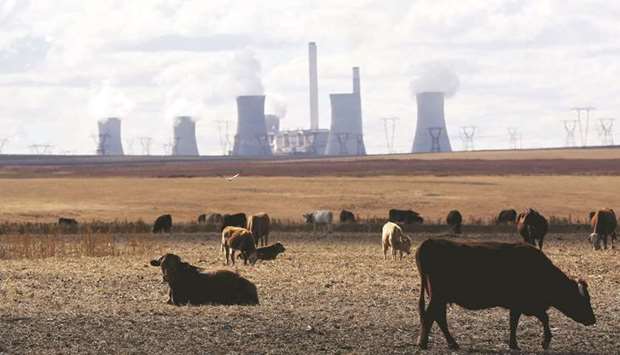Blackouts have had South Africans firing up candles, flashlights and generators as crisis-plagued Eskom Holdings SOC Ltd, which provides most of the country’s electricity, struggles to meet demand. The state-owned company took almost 10% of its generation capacity offline in recent weeks to prevent the collapse of the national grid, a consequence of construction problems at two new plants and years of deferred maintenance. But Eskom’s problems run far deeper. It’s mired in debt and isn’t selling enough energy to cover all its costs, leaving it scrambling for money to replace ageing plants. Now South Africa plans to bail out the utility and split it into three entities in the hope of reviving its fortunes.
1. What caused the power shortages?
Theoretically Eskom should be able to generate about 47,000 megawatts of power, but output fell as low as 26,000 megawatts when several of its plants were being serviced or broke down. The power crunch peaked in February when six of the utility’s units unexpectedly went off line, resulting in some of the worst outages the country has ever seen. A lack of money forced the utility to cut back on maintenance and repairs, and it lacks key technical skills needed to carry out the work, despite having a bloated workforce. Plants that produce more than half Eskom’s power are at, or nearing, their ideal retirement age.
2. How did this happen?
South Africa was able to produce more electricity than it needed when white-minority rule ended in 1994, but the government didn’t foresee how sharply demand would spike as the economy expanded and previously neglected black areas were connected to the grid. Eskom announced a series of multibillion-dollar investments after the government awoke to the severity of the problem in the mid-2000s, but the projects came too late and took too long to build. The first wide-scale outages occurred in late 2005. The Medupi and Kusile coal-fired plants, which were supposed to add almost 9,600 megawatts to the grid and be fully operational in 2015, are still years away from completion. Their projected costs have more than doubled to 292.5bn rand ($21.2bn).
3. Where was management?
The utility went through repeated board and management changes during the almost nine years Jacob Zuma was South Africa’s president. Investigations by lawmakers and the nation’s graft ombudsman alleged that the upheaval was part of an orchestrated attempt by Zuma’s allies to raid Eskom’s coffers with his tacit consent. Accusations that the utility was looted are now being investigated by a judicial commission. Zuma and his allies deny wrongdoing. Eskom’s board and management were replaced in January 2018, the month after Cyril Ramaphosa succeeded Zuma as head of the ruling party, the African National Congress. Since then, there’s been a concerted effort to stamp out graft, and a number of senior executives and staff have left the company. Ramaphosa was named South African president in February 2018, after the ANC forced Zuma to step down.
4. How precarious is Eskom’s financial position?
Very. By its own admission, it’s in a “death spiral.” It is saddled with 419bn rand worth of debt that it’s battling to service, and it anticipates showing a loss of about 20bn rand for the year ending in March. Sales volumes are at a decade low and continue to fall as the economy stagnates. Increasing numbers of businesses and middle-class consumers have moved off the grid as the price of renewable energy drops. Meanwhile, near-bankrupt municipalities are falling behind in paying their bills as customers in impoverished townships default on their debts or steal power through illegal connections.
5. What’s being done to get the utility back on track?
Ramaphosa plans to split into separate generation, distribution and transmission businesses under a state holding company, a reorganisation he says will enable each unit to manage its costs more effectively and make it easier for them to raise funding. The budget announced on February 20 includes an almost $5bn cash injection over the next three years – the largest bailout in South Africa’s history – to help Eskom service its debt and free up money for operations. Eskom had floated a proposal for the government to take over some of its debt – an option not favoured by Finance Minister Tito Mboweni, who is trying to stick to debt ceilings and preserve the country’s sole remaining investment-grade rating. The company is also considering selling assets and firing as many as 16,000 staff. That proposition would meet with fierce resistance from labour unions, which also oppose the breakup plan.
6. What happens if it fails?
The total collapse of Eskom isn’t on the immediate horizon, and it’s hard to see the government allowing it to happen. The utility provides about 95% of the nation’s power. If it were to cease operating or the grid were to collapse, South Africa’s economy would grind to a halt and many businesses would be driven into bankruptcy, triggering investor flight and multiple downgrades to the nation’s fragile credit rating – as well as potential social unrest. The ongoing power cuts are already weighing on South Africa’s rand and bonds, and present a huge risk to smelters, mines and other energy-intensive businesses.

Cows graze as steam rises from the cooling towers of Matla Power Station, a coal-fired power plant operated by Eskom in Mpumalanga province, South Africa. The country plans to bail out the utility and split it into three entities in the hope of reviving its fortunes.
